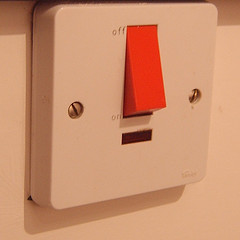I want to do EFT for a major issue in my life, but somehow I always find an excuse not to do EFT. I know it will help me. I do want to get over this, but it just doesn’t happen. What can I do?
 photo by (Erik) |
I have been teaching people Emotional Freedom Techniques (EFT) for a number of years.
I’ve noticed an interesting pattern. Certain people learn to use EFT, see the benefit of it in their lives, and yet have decided it’s not for them.
At first I took this as some sort of failure on my part. I thought, “I must have done something to turn them off to this very powerful tool.”
My point of view changed while working with a friend. Someone in her life had been hurt in a very violent way. The loved one was hundreds of miles away. She was disappointed in herself for not being able to stop it from happening, she was sad for the attack, she was scared that her loved one was not going to seek the attention she needed out of fear, she felt helpless from such a great distance, and she worried it would happen again. These were just a few of the emotions racing through her head.
We agreed that I would come over in a few days so we could do some work. When I got to her place we talked about everything in the world, except what I had come for. This continued for almost 45 minutes. Finally I said, “Do you want to do this or not?”
I wasn’t frustrated or angry; I was giving her an out. Sometimes people feel safer having these types of conversations with a paid professional rather than a close friend.
She hemmed and hawed as she tried not to answer.
So I asked, “Why are you afraid to do the work?”
“Because it’s going to hurt. I know how raw my emotions are right now. I feel like I’ve let my loved one down. I don’t want to wander into that pain.”
All of that was fair. I asked her, “How large are all the emotions you’re feeling?” (This was for the emotions around her loved one plus the emotions around her fear of having to get into the problem).
With her hands she showed something about the size of a beach ball.
We did some work on her fear of what we might uncover and how much it was going to hurt to dive into the emotions of the circumstance.
I then asked her how much emotion was left (in all areas). She gestured to show something about 30% of the size of the original.
This was a useful insight for me. She was more emotional about her reaction to the incident than she was about the incident itself.
Later, as I reflected on this, it brought to mind all of the people — myself included — who avoided doing work in some area of our lives because we were afraid of what we’d uncover about ourselves.
The belief is, “The crap I know right now is better than the crap around the corner. Sure, my life isn’t perfect right now, but I can manage the pain and disappointment I am facing now. If I go looking to change my life, who knows what I’ll stir up.”
This is not an indictment for not wanting to look under the bed to see what’s really under there. The beauty of free will is that we choose who we want to be. There are outcomes and consequences to those choices. Our decision to face or not face the ideas we have, about ourselves and the world, that hold us back determines whether our lives change. And for better or worse that is our prerogative.
I have just found that in the long run it’s better to get out the flashlight and face whatever is hiding under the bed, no matter how scary it is at the time.










